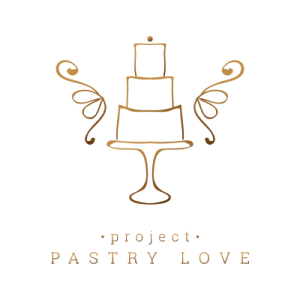Frosting a cake and making it smooth before decorating can be a bit tricky, but not impossible. There are a couple things to keep in mind when learning how to frost a cake. First of all, the buttercream needs to be at the right temperature. If it is too cold, then it will be difficult to spread, and if it is too warm it could just drip off of the cake. If it does get too warm while you’re frosting you can put the buttercream and the cake in the refrigerator to chill it a bit. Secondly, it is important that your cake layers are equal in height, and leveled straight. This will ensure that your frosted cake won’t look like the Leaning Tower of Pisa–unless you are going for that look. Thirdly, the cakes should be completely cooled before frosting. Fourth, take your time, and if you need to take a break just pop the cake in the refrigerator. Finally, as in everything in life, practice makes perfect.
I used an all butter, strawberry French buttercream to demonstrate this process. Click here for this recipe.
The equipment recommended are as follows: straight spatula, an off-set spatula, a larger off-set spatula, a pastry brush, straight bench scraper, and (not pictured) a tall glass filled with warm water, a kitchen towel, and a glass of wine (to get you through). I usually use 4 of these tools (the smaller off-set spatula, the pastry brush, the glass with warm water, and the kitchen towel), but you may find the others handy. I have never used a turntable, but I imagine that they are extremely useful–especially when smoothing out the sides.
To begin, smear a little buttercream in the middle of your cake plate. This should help hold the cake in place while you frost.
Place the first layer of cake centered on the plate with the bottom side up. This ensures a flat service. Take 4 strips of parchment paper and tuck them under the cake on all sides. The parchment will catch any buttercream while you frost. After you have frosted and decorated your cake remove the parchment pieces and voila!–your cake plate is clean.
Take some buttercream and spread it evenly on top of the first layer.
Place the second layer, bottom side up, on top of the filling. With the pastry brush, gently sweep away any loose crumbs.
Frost the top and sides of the cake with some buttercream, and spread it all around to create a thin coat.
This is called the “crumb coat”. It locks in the potentially loose crumbs, so that when you frost the cake with the remaining buttercream there won’t be any cake bits in the frosting.
Refrigerate the “crumb-coated” cake for at least 20 minutes, or until the buttercream has hardened.
When ready, add some buttercream on top of the cake and gently spread it around the top and down the sides. It will look rough. Never mind that. You’ll be smoothing it out soon. Just make sure that every bit of the cake is covered.
Once the sides have been frosted, take your off-set spatula (which ever size you wish), and on an angle with a little bit of pressure, carefully glide it around the cake. This will help clean it up and smooth it out. The bench scraper is also a good tool to use for this part.
Dip your spatula in the warm water, dry it with a towel, and bring up some of the frosting on the edge of the cake towards the middle. It helps to dip and dry between every stroke. This melts the buttercream just a bit to create a smoother look. You can use this technique when cleaning up the sides and top as well.
Finally, smooth out the top, adding more buttercream if needed. I usually take my off-set spatula and, on an angle, spiral it in.
Now you’ve a blank canvas! Decorate your cake how ever you’d like.














